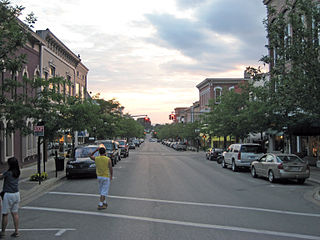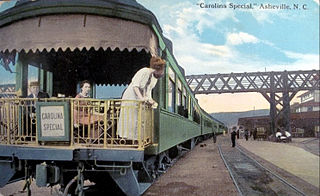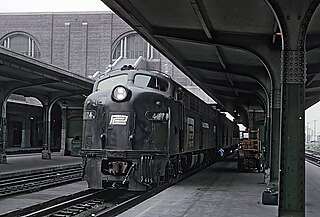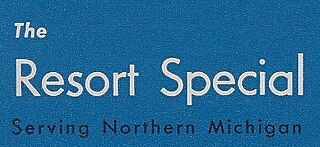
Petoskey is the largest city and the county seat of Emmet County, Michigan, and is the largest settlement within the county. Petoskey has a population of 5,877 at the 2020 census, up from 5,670 at the 2010 census.

Reed City is a city in the U.S. state of Michigan. The population was 2,490 at the 2020 census. It is located in southwestern Osceola County and is the county seat.
The Baltimore and Ohio Chicago Terminal Railroad is a terminal railroad in the Chicago area, formerly giving various other companies access to (Chicago's) Grand Central Station. It also served to connect those railroads for freight transfers, and is now controlled by CSX Corporation, the successor to the Baltimore and Ohio Railroad.

The Grand Rapids and Indiana Railroad at its height provided passenger and freight railroad services between Cincinnati, Ohio, and the Straits of Mackinac in Michigan, USA. The company was formed on January 18, 1854.

The Cincinnatian was a named passenger train operated by the Baltimore and Ohio Railroad (B&O). The B&O inaugurated service on January 19, 1947, with service between Baltimore, Maryland and Cincinnati, Ohio, carrying the number 75 westbound and 76 eastbound, essentially a truncated route of the National Limited which operated between Jersey City, New Jersey and St. Louis.

The Union Depot is a former train station, located at 637 E. Michigan Avenue in Lansing, Michigan. It was listed on the National Register of Historic Places in 1995. Despite the union name, Grand Trunk Western trains stopped at a different station 1 mile away. Lake Shore and Michigan Southern Railway trains of the former Lansing Division stopped at another station a quarter mile away.
The Michigan Northern Railway was a railroad that provided service to the northern part of the Lower Peninsula of Michigan from 1976 to 1986. At the beginning of service on April 1, 1976, the MIGN operated the former Grand Rapids and Indiana Railroad from Comstock Park to Mackinaw City and the Walton Junction Branch to Traverse City. In 1982, the MIGN assumed operation of the former Chesapeake and Ohio Railway from Grawn to Williamsburg and from Charlevoix to Petoskey, and the former Ann Arbor Railroad from Alma to Frankfort.

The Cincinnati Limited was a named train of the Pennsylvania Railroad; the train traveled from New York City's Pennsylvania Station to the Cincinnati Union Terminal. It was a rival to New York Central's Ohio State Limited. The Cincinnati Limited carried connecting sleeping cars to the Louisville and Nashville Railroad's Cincinnati to New Orleans Pan American. By the mid-1950s, the sleeper extension on L&N lines ended at Memphis instead of New Orleans.

The Pennsylvania Railroad Station in Fort Wayne, Indiana, also known as Baker Street Station, is a former passenger rail station in downtown Fort Wayne, Indiana. The American Craftsman-style station opened to the public March 23, 1914, at a cost of $550,000.

The Carolina Special was a passenger train operated by the Southern Railway between Cincinnati, Ohio, and the Carolinas. It operated from 1911 to 1968. It was the last passenger train to use the route of the Charleston and Hamburg Railroad, which, as the South Carolina Canal and Railroad Company, began operation in December 1830, as one of the oldest railroads in the United States, and, by 1833, operated a 136-mile (219 km) line to Hamburg, South Carolina, on the Savannah River, the country's longest at that time. All Southern Railway Pullman service to Charleston rode over that historic, if bucolic, route from Branchville to the port city.

The Chesapeake & Ohio Railway Station is a railway depot located in Pioneer Park on West Lake Street in Petoskey, Michigan. It was placed on the National Register of Historic Places in 1970. The building now houses the Little Traverse Historical Museum.
The Southland was a night train between Chicago, Illinois and different points in western and eastern Florida from 1915 to 1957. In the early years it was called the New Southland. It was distinctive among Midwest to Florida trains as its western branch was the only all-season mid-20th-century long-distance train passing from Georgia to Florida bypassing the usual passenger train hub of Jacksonville Union Station. The main operator was the Louisville and Nashville Railroad, and pooling partners were the Pennsylvania Railroad, the Atlantic Coast Line Railroad and to lesser extent, the Wabash Railroad and the Florida East Coast Railway. For southeast bound -but not northwest bound- trips to Norfolk, Virginia, some coaches in 1946 diverged at Cincinnati along a Norfolk and Western Railway route. Northwest bound, travelers could switch trains at Cincinnati for heading towards Chicago.
The Aiken-Augusta Special was a named night train of the Southern Railway between New York City and Augusta, Georgia. Different from other long distance Southern Railway lines which tended to briefly go through the northwestern edge of South Carolina, this route went through the interior of the state. Its route marked the last directly north-south route between Charlotte, North Carolina, and Columbia, South Carolina, and it marked one of the last long distance trains into Augusta, Georgia.
The Del-Mar-Va Express was a named passenger train of the Pennsylvania Railroad that at its peak went from New York City to the southernmost point of the Delmarva Peninsula, Cape Charles, Virginia. Initiated in 1926, the train's north–south passage through Delaware stood in contrast with the main passenger traffic through Delaware being a brief passage through cities in the upper reach of Delaware, mainly Wilmington. Most importantly, the train served as a more direct path from New York City and Philadelphia to Norfolk, Virginia, by way of a ferry from Cape Charles across the Chesapeake Bay to Norfolk, a path that bypassed Baltimore and Washington, D.C. This saved time in comparison to travel over PRR, Atlantic Coast Line and Norfolk & Western trains through Washington to Norfolk. The Del-Mar-Va trip, including ferry travel was 11 hours from New York; and the longer all-land route through Washington was 13 hours and 40 minutes.

The Buffalo Day Express was a long-distance north–south Pennsylvania Railroad passenger train from Washington, D.C., to Buffalo, New York. It had a second branch that originated in Philadelphia, Pennsylvania, and at times, from New York, New York. In the southbound direction, the train ran by the name, Washington Express. It was the longest running of trains on the Washington-Buffalo route, north through central Pennsylvania on the Buffalo Line, operating from 1900 to the latter years of the 1960s, with a shortened segment until 1971.

Grand Rapids Union Station was a union station in Grand Rapids, Michigan. A Georgian Revival building of two stories, it was built in 1900 on 61 Ionia Avenue SW and was closed in 1958. The building was demolished in 1958 and 1959 to make space for the U.S. Route 131 highway.

The Resort Special was a seasonal night train from Chicago, renowned for serving resort towns such as Traverse City, Charlevoix, Petoskey on the northwestern part of Michigan’s lower peninsula. Begun by the Pere Marquette Railway, it was a rare instance of a named Pere Marquette train continuing after the Chesapeake & Ohio absorbed the Pere Marquette Railway in 1947. In 1960s, the C&O shifted the Resort Special name to a White Sulphur Springs, West Virginia to New York City route.

Canton station, or Canton–Akron station, is a former train station in Canton, Ohio.
The Canadian and later, Canadian-Niagara, was the longest running named international train from Chicago to Upper Canada via Detroit, for its first two decades running to Montreal. This overnight train was operated by the Michigan Central Railroad from Chicago to Detroit, and in a pool arrangement, it operated over Canadian Pacific Railway tracks and used the same train number from Detroit eastward. The train would carry a second section, bound, variously for Buffalo or New York City via Buffalo.
The Grand Rapids, Indiana and Mackinaw Railroad was a railroad company in the United States. It was incorporated in 1881 to extend the main line of the Grand Rapids and Indiana Railroad north from Little Traverse Bay to the Straits of Mackinac. The line opened in 1882. The company was consolidated with the Grand Rapids and Indiana Railroad in 1884. The line passed through the Pennsylvania Railroad to Penn Central and was subsequently abandoned in 1992.












